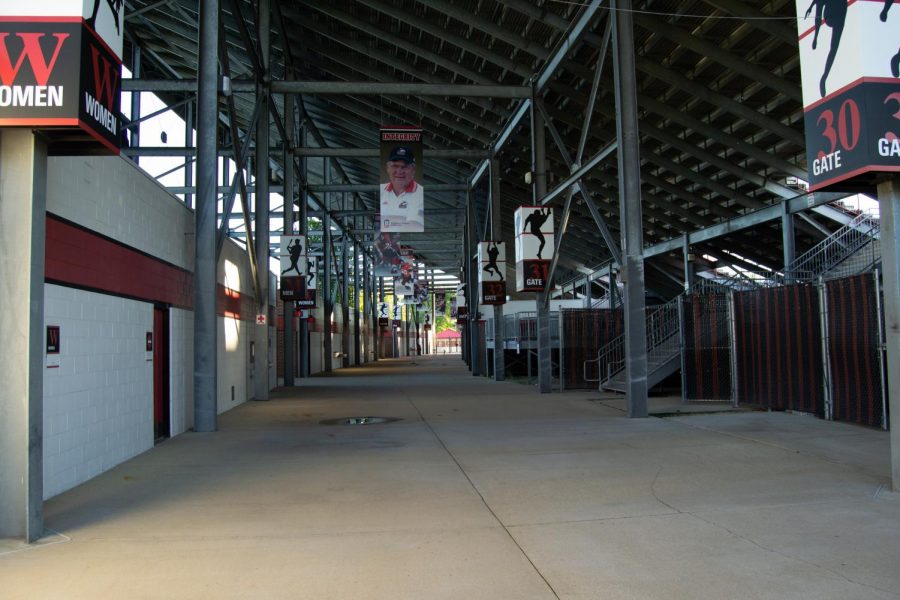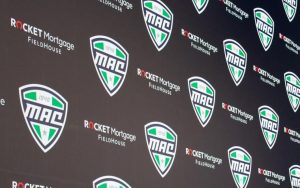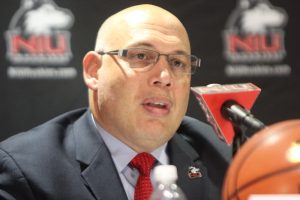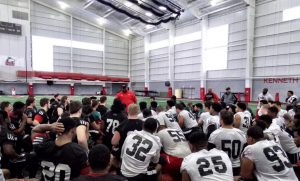It’s a long and necessary process for college sports to return
A view from under the home bleachers Sept. 23, 2019 at Huskie Stadium.
August 22, 2020
Just over five months ago, I sat in a Cleveland hotel room the night before the Mid-American Conference men’s basketball tournament and watched the sports world melt down.
Ever since, I’ve tempered any expectations I might have when it comes to the return of sports.
You could say I’ve compartmentalized it. After all, when hundreds of thousands of people are in one way or another affected by a pandemic, there are more important things going on than when we get to see sports again. That’s what I tell myself.
I’ve always tended to think of the worst thing that can happen in a situation, and prepare myself ahead of time for how I will react. I’m not alone, am I?
So when it was announced last week that the MAC was canceling all fall sports, I didn’t really react to it the way I thought I would. As in, I thought I would actually have feelings about it, but I really don’t, which makes me a little bit sad.
I didn’t even have a hot take about it! But I have thought of all of this for quite some time, and I’ve reached the point that I’m prepared to deal with cancellations for the foreseeable future. I’ve put on my “be objective” hat and that will be my M.O. moving forward.
I feel I have to be that way. I commend NIU Athletic Director Sean Frazier and NIU President Lisa Freeman for putting the safety of the athletes first. I am in total agreement with what they decided to do, and along with the rest of the conference, proved that there are still adults in the room in a few places.
I know money and the risk of possible liability both played into the decisions. There’s no problem admitting that, unless it makes you uncomfortable that college age amateur athletes are competing with no guarantees to their future health and safety. Did we mention they don’t get even a crumb of the billion-dollar pie they see everyone else get to share?
We’ve already discovered that stopping the spread of COVID-19 is going to be difficult enough on college campuses. That manifested itself this week when the University of North Carolina-Chapel Hill and the University of Notre Dame announced starting Wednesday all classes will be online, just over a week after welcoming students back to campus.
Throw in athletes traveling back and forth across the country competing against each other, then returning to their communities, and you’re moving towards the “perfect storm” scenario.
I’d love that to not be the case. I wish life were back to normal. But it isn’t, no matter how hard we try to wish COVID-19 away.
That’s the sad part, and that’s why it’s hard to be positive about the future of sports. It’s difficult to see a future when some won’t even admit that our lives need to be different for a while, and won’t make the sacrifices necessary to allow us to someday have a functioning society again.
People like to use the term “common sense”. Tell me, if we as a country are trying to contain the COVID-19 virus, how does sending a team from Baton Rouge, LA to Gainesville, FL, for example, help in that containment? Then, after said game, both teams head back to campus and socialize with not only each other, but the rest of campus?
I’ve never been good at science, but that doesn’t fit the definition of common sense.
But have we really ever had it for football? We are so gaga for the game that we can’t even step back and realize that it’s ridiculous to even be having this conversation. You can come at me with all of your stats about young people and COVID-19, but the fact of the matter is that the virus has already altered the lives of several athletes.
Many have this idea that it’s OK for the virus to run through our population and casualties are just something we have to deal with, because among the young, everyone is going to be “fine.” Right?
Tell that to Georgia State University first-year quarterback Mikele Colasurdo, who’s career may be over after testing positive for COVID-19 and now being diagnosed with a heart ailment, or Indiana University first-year offensive lineman Brady Feeney, who’s entire life may be affected due to his bout with the virus.
Risk abounds in all of our lives, but in everyday walks of life we take precautions to minimize that risk as much as we can. We wear seatbelts in our cars, football players wear pads and helmets with the latest in safety technology, and we don’t spend time outside where there is lightning in the area.
We all want our lives to get back to normal, I get that. But again, we can’t just wish for that to happen. Five years ago, I shattered my left humerus and had a plate and 14 screws surgically put in my arm. I then spent eight months rehabbing.
By about two months in, I wanted to be back to my normal life, but I had no choice but to go through the whole process to get there. There was no rushing through it, and lying in bed at night wishing my arm was better didn’t help either.
That’s where we are right now. We are in the process, and the end of that process looks to be a ways away.
Right now, the MAC is planning for fall sports in the spring, and I hope it happens. One, because I want all athletes affected to be able to play their competitive sport and two, I love football and look forward to my second season covering it for this newspaper.
All it takes to get there is a little common sense. Let’s all work hard to find it.










